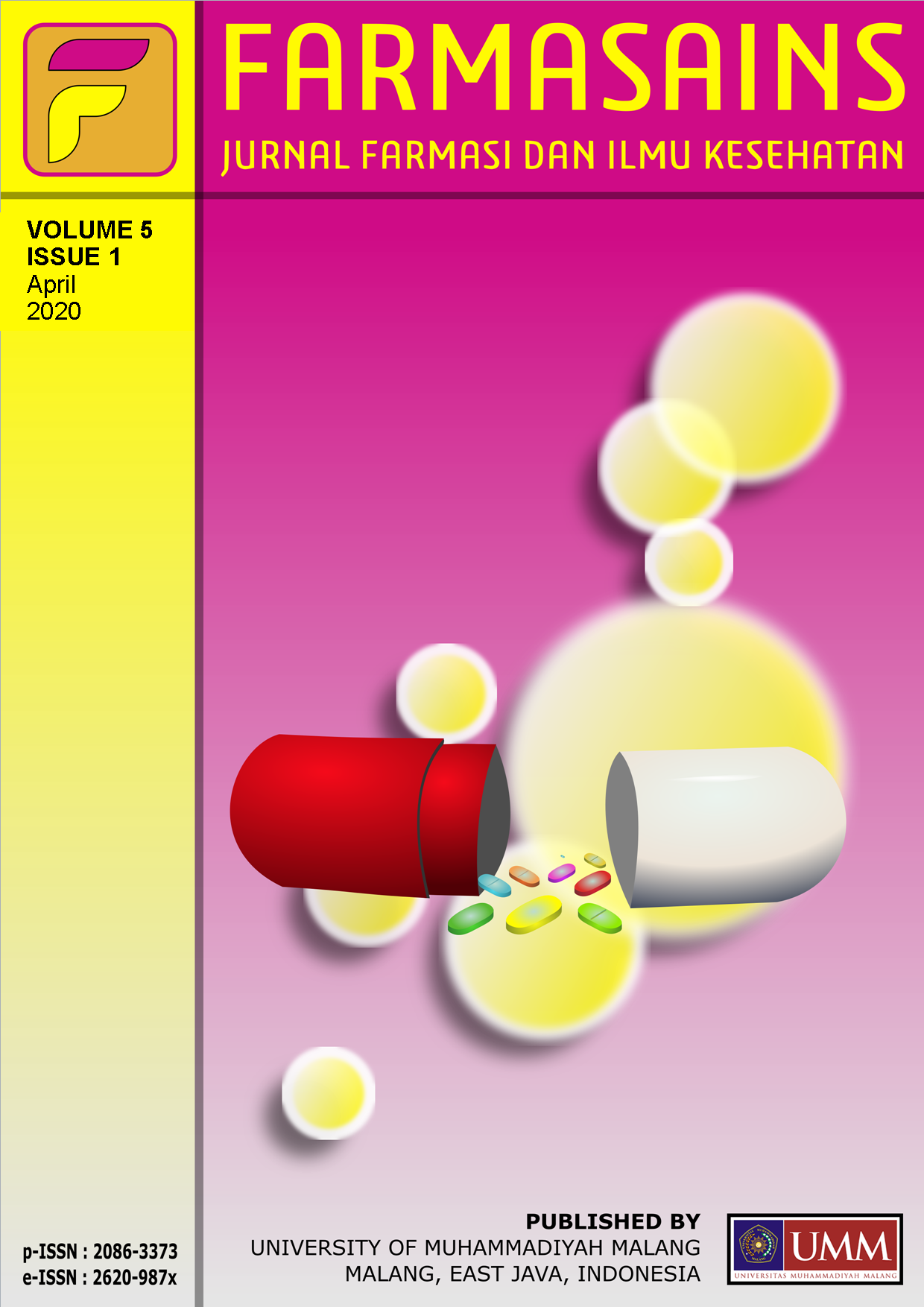Plant cyanogenic glycosides: an overview
DOI:
https://doi.org/10.22219/farmasains.v5i1.10047Keywords:
Cyanogenic glycosides, phytochemistry, toxicityAbstract
The cyanogenic glycosides have consisted of α-hydroxy nitrile aglycone and a sugar moiety that producing hydrogen cyanide (HCN) during the hydrolysis process. This HCN-producing property underlines the toxicity of the plants commonly associated with these compounds in humans and animals. However, new evidence shows that the toxicity of these compounds is lower than those theoretically caused by the equivalent released HCN. In order to provide a deeper understanding of cyanogenic glycosides, an overview of these compounds is given in this article. It covers the chemistry, distribution, biosynthesis, toxicity, determination, as well as extraction and isolation of the compounds.
Downloads
References
Abraham, K., Buhrke, T., & Lampen, A. (2016). Bioavailability of cyanide after consumption of a single meal of foods containing high levels of cyanogenic glycosides: A crossover study in humans. Archives of Toxicology, 90(3), 559-574. doi:10.1007/s00204-015-1479-8
Ahn, Y. O., Saino, H., Mizutani, M., Shimizu, B., & Sakata, K. (2007). Vicianin hydrolase is a novel cyanogenic beta-glycosidase specific to beta-vicianoside (6-O-alpha-L-arabinopyranosyl-beta-D-glucopyranoside) in seeds of Vicia angustifolia. Plant and Cell Physiology, 48(7), 938-947. doi:10.1093/pcp/pcm065
Aikman, K., Bergman, D., Ebinger, J., & Seigler, D. (1996). Variation of cyanogenesis in some plant species of the midwestern United States. Biochemical and Systematic Ecology, 24(7-8), 637-645. doi:10.1016/S0305-1978(96)00069-5
Bolarinwa, I. F., Orfila, C., & Morgan, M. R. A. (2015). Determination of amygdalin in apple seeds, fresh apples, and processed apple juices. Food Chemistry, 170, 437-442. doi:10.1016/j.foodchem.2014.08.083
Bone, K., & Mills, S. (2013). Principles of Herbal Pharmacology. In Principles and Practice of Phytotherapy: Modern Herbal Medicine (2nd ed.). London, UK: Churchill Livingstone.
Campa, C., Schmitt-Kopplin, P., Cataldi, T. R. I., Bufo, S. A., Freitag, D., & Kettrup, A. (2000). Analysis of cyanogenic glycosides by micellar capillary electrophoresis. Journal of Chromatography B: Biomedical Sciences and Applications, 739(1), 95-100. doi:10.1016/S0378-4347(99)00375-8
Choudhury, D., Sahu, J. K., & Sharma, G. D. (2012). Value addition to bamboo shoots: A review. Journal of Food Sciences and Technology, 49(4), 407-414.
Cressey, P., & Reeve, J. (2019). Metabolism of cyanogenic glycosides: A review. Food and Chemical Toxicology, 125, 225–232. doi:10.1016/j.fct.2019.01.002
Dellagreca, M., Fiorentino, A., Monaco, P., Previtera, L., & Simonet, A. M. (2000). Cyanogenic glycosides from Sambucus Nigra. Natural Product Letter, 14(3), 175-182.
Dewick, P. M. (2009). The Acetate Pathway: Fatty Acids and Polyketides. In Medicinal Natural Products: A Biosynthetic Approach (3rd ed.). Hoboken, NJ:John Wiley & Sons Ltd.
Eyjólfsson, R. (1970). Isolation and structure determination of triglochinin, a new cyanogenic glucoside from Triglochin maritimum. Phytochemistry, 9(4), 845-851.
Gleadow, R. M., Haburjak, J., Dunn, J. E., Conn, M. E., & Conn, E. E. (2008). Frequency and distribution of cyanogenic glycosides in Eucalyptus. Phytochemistry, 69(9), 1870-1874.
Majak, W., & Cheng, K. J. (1987). Hydrolysis of the cyanogenic glycosides amygdalin, prunasin and linamarin by ruminal microorganisms. Canadian Journal of Animal Science, 67(4), 1133-1137.
Müller-Schwarze, D. (2009). Test for Cyanogenic Compounds in Plants. In D. Müller-Schwarze (Ed.), Hands-On Chemical Ecology (pp. 69-73). New York, NY: Springer. doi:10.1007/978-1-4419-0378-5
Olsen, K. M., Sutherland, B. L., & Small, L. L. (2007). Molecular evolution of the Li/li chemical defence polymorphism in white clover (Trifolium repens L.). Molecular Ecology, 16(19), 4180-4193. doi:10.1111/j.1365-294X.2007.03506.x
Panter, K. E. (2018). Cyanogenic Glycoside - Containing Plants. In R. C. Gupta (Ed.), Veterinary Toxicology: Basic and Clinical Principles (Third Ed., pp. 935-940). Houston, TX: Elsevier Inc. doi:10.1016/B978-0-12-811410-0.00064-7
PubChem. (2019). Explore Chemistry. U.S. National Library of Medicine. Retrieved from https://pubchem.ncbi.nlm.nih.gov/
Roulard, R., Fontaine, J., Jamali, A., Cailleu, D., Tavernier, R., Guillot, X., ... & Mesnard, F. (2017). Use of qNMR for speciation of flaxseeds (Linum usitatissimum) and quantification of cyanogenic glycosides. Analytical and Bioanalytical Chemistry, 409(30), 7011-7026. doi:10.1007/s00216-017-0637-7
Schulz, V., Hansel, R., Blumenthal, M., & Tyler, V. E. (2004). Rational Phytotherapy: A Reference Guide for Physicians and Pharmacists (5th ed.). Berlin, Germany: Springer-Verlag Berlin Heidelberg.
Seigler, D. S. (1975). Isolation and characterization of naturally occuring cyanogenic compounds. Phytochemistry, 14(1), 9-29.
Shlichta, J. G., Glauser, G., & Benrey, B. (2014). Variation in cyanogenic glycosides across populations of wild lima beans (Phaseolus lunatus) has no apparent effect on bruchid beetle performance. Journal of Chemical Ecology, 40(5), 468-475. doi:10.1007/s10886-014-0434-0
Sun, Z., Zhang, K., Chen, C., Wu, Y., Tang, Y., Georgiev, M. I., ... & Zhou, M. (2018). Biosynthesis and regulation of cyanogenic glycoside production in forage plants. Applied Microbiology and Biotechnology, 102(1), 9-16. doi:10.1007/s00253-017-8559-z
Tivana, L. D., Da Cruz Francisco, J., Zelder, F., Bergenståhl, B., & Dejmek, P. (2014). Straightforward rapid spectrophotometric quantification of total cyanogenic glycosides in fresh and processed cassava products. Food Chemistry, 158, 20-27. doi:10.1016/j.foodchem.2014.02.066
Vetter, J. (2017). Plant Cyanogenic Glycosides. In P. Gopalakrishnakone, C. R. Carlini, & R. Ligabue-Braun (Eds.), Plant Toxins (pp. 288-315). Berlin, Germany: Springer Science+ Business Media. doi:10.1007/978-94-007-6464-4
Waszkowiak, K., Gliszczynska-Swiglo, A., Barthet, V., & Skrety, J. (2015). Effect of extraction method on the phenolic and cyanogenic glucoside profile of Flaxseed extracts and their antioxidant capacity. Journal of American Oil Chemists’ Society, 92, 1609-1619. doi:10.1007/s11746-015-2729-x
Downloads
Published
How to Cite
Issue
Section
License
Authors who publish with this journal agree to the following terms:
a. Authors retain copyright and grant the journal right of first publication with the work simultaneously licensed under a Creative Commons Attribution License that allows others to share the work with an acknowledgement of the work's authorship and initial publication in this journal.
b. Authors are able to enter into separate, additional contractual arrangements for the non-exclusive distribution of the journal's published version of the work (e.g., post it to an institutional repository or publish it in a book), with an acknowledgement of its initial publication in this journal.
c. Authors are permitted and encouraged to post their work online (e.g., in institutional repositories or on their website) prior to and during the submission process, as it can lead to productive exchanges, as well as earlier and greater citation of published work (See The Effect of Open Access).













